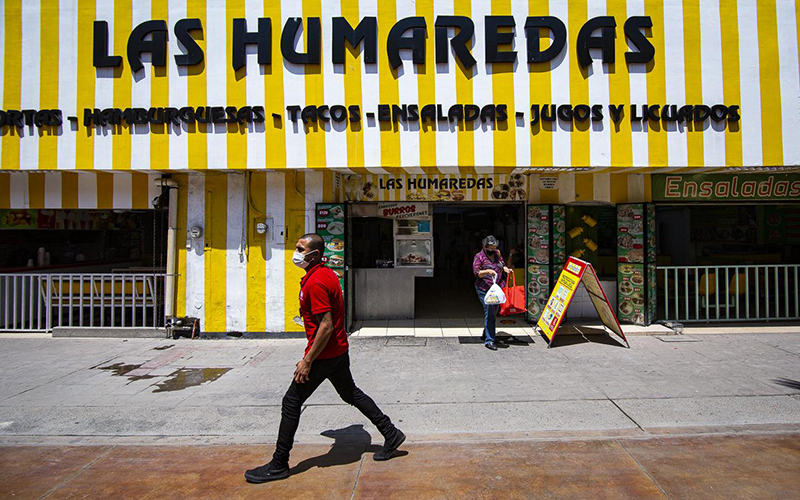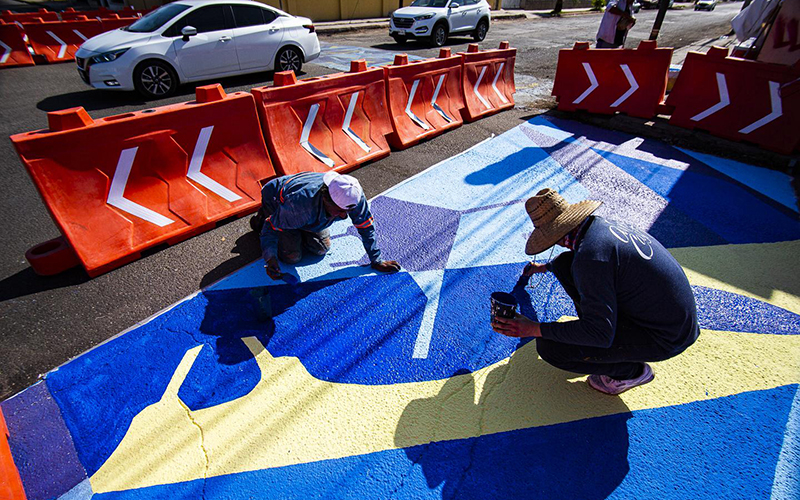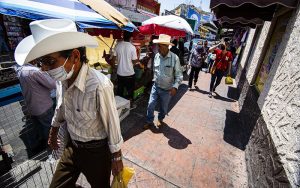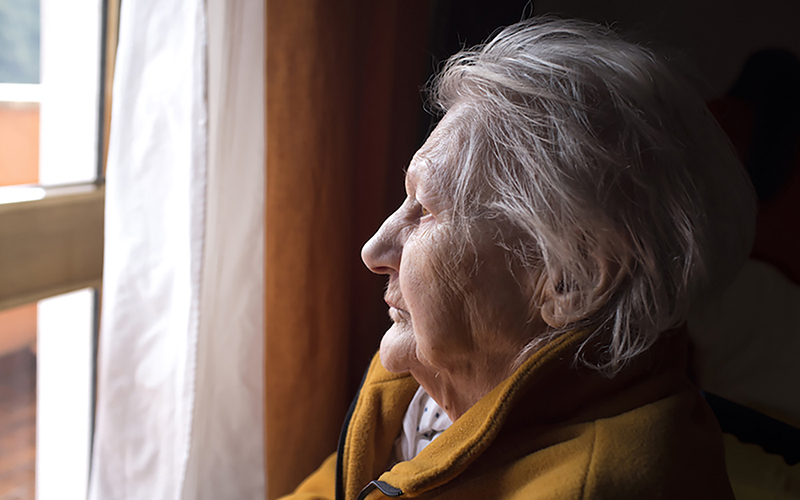
A man walks along a recently converted cars-free plaza in congested downtown Hermosillo, Mexico. Planners and business owners say protecting pedestrians will benefit the local economy. (Photo by Murphy Woodhouse/KJZZ)
HERMOSILLO, Mexico – Protected from the bustling traffic by a wall of orange plastic barriers, graphic artist Andres Castro was crouched and painting a crosswalk with vivid blues and yellows on a recent weekday morning.
“We’re trying to represent elements or activities that are done in our state,” Castro said. “For example, this is the Sea of Cortez crossing, and the sea’s fauna are represented.”
When it’s done, whales, manta rays and other denizens of the famously biodiverse sea will add color to the intersection in the Cinco de Mayo neighborhood. Six additional crosswalks in the neighborhood will have other regional themes, including Sonoran cuisine and Indigenous traditions.
Beyond adding some color to the neighborhood, the goal of the crosswalks is to increase visibility of the city’s imperiled pedestrians. It’s one of several projects Hermosillo is pursuing to make the city of more than 850,000 safer for everyone on the road.
“You’ve got to be careful,” Castro said of walking in the city, whose motorists are notorious for driving fast and without sufficient caution. “You’ve got to look both ways.”
The crosswalk project was pitched by Omar Garza, Luisa Verdugo and Marianna Longoria – now graduates of Tec de Monterrey’s Hermosillo campus — and is supported by a program at New York University and city planning officials.
While Castro was painting, Cinco de Mayo resident Rosa Fernández and a friend walked by on their daily 2-mile stroll.
“We walk every morning at 6:30,” she said, but today was an exception. “We just slept in.”
Fernández said she hopes the new crosswalks help, because she says she and the other regular neighborhood walkers don’t always feel safe, especially at intersections.
Troubling numbers
And her anxiety is backed up by federal data. From 2017 to 2019, the most recent year available, more than 60 pedestrians were killed in Hermosillo, and more than 700 were injured.
Compared with other large Mexican cities, Hermosillo is among the most dangerous for pedestrians — and all users of the road, according to a KJZZ analysis of that data.
More recent city data obtained by KJZZ through a public records request shows that 18 pedestrians were killed in 2020, and five more through April of this year.

Daniel Franco Garza, with backpack, is a University of Illinois Chicago doctoral student who has studied downtown Hermosillo and ways to make it safer for pedestrians. (Photo by Murphy Woodhouse/KJZZ)
Pedestrians aren’t a priority
“Basically, it’s not good,” said Lupita Peñuñuri, director of the municipal urban planning body IMPLAN, when asked to describe the situation faced by pedestrians in Hermosillo.
For years, cars have been prioritized by planners, to the detriment of pedestrian infrastructure, she said. The result is crumbling or nonexistent sidewalks with inadequate accommodations for those with disabilities; wide, high-speed thoroughfares with few safe places to cross and traffic lights that don’t give enough time for those on foot.
Newer rules now require better pedestrian features for new construction, but reversing the legacy of older policies and priorities will be a long process, Peñuñuri said.
She described the level of pedestrian death and injury as a longstanding crisis, but one that many Hermosillo residents have accustomed themselves to, or rationalized as the price of progress. But there’s nothing inevitable about it, Peñuñuri said.
To challenge that mindset and try to make the city’s streets safer, Hermosillo in 2019 adopted what’s known as a Vision Zero policy, which aims to eventually reduce roadway deaths to zero. Hermosillo is one of the few Mexican cities to institute the policy, which was enacted in Mexico City a few years ago.
Part of that is simply studying where pedestrians and cyclists are getting hit, so that officials know where to make changes, Peñuñuri said. But it also involves adding bike lanes and projects like the painted crosswalks.

Hermosillo graphic designer Andrés Castro, right, came up with the design for a crosswalk in the Cinco de Mayo neighborhood. (Photo by Murphy Woodhouse/KJZZ)
More pedestrians, more business
Another major area of concern, and also some recent improvements, is Hermosillo’s bustling center.
“It’s the place where the most people walk,” said Daniel Franco Garza, an urban planning doctoral student at the University of Illinois Chicago who has studied downtown Hermosillo and ways to make it more pedestrian friendly. “But at the same time, it’s the most problematic.”
He said those on foot face dense traffic, high-strung drivers and inadequate sidewalks, among many other issues.
“If the mobility of pedestrians is limited, then pedestrian access to the city’s assets is limited,” Franco said, adding that many Hermosillenses depend on public transportation, bikes or their own two feet to get around.
And despite being the vast majority of customers at the center’s many businesses, pedestrians haven’t been prioritized.

Most people get to Hermosillo’s downtown shops by foot. Despite that, many say drivers have been a greater priority than pedestrians. (Photo by Murphy Woodhouse/KJZZ)
“More pedestrian access means more clients for business,” Franco said.
But there are signs of change. Last fall, a block-long stretch of road was converted to a pedestrians-only walkway. Franco thinks much more is needed, but that it represents a step in the right direction.
Miguel Angel Figueroa is a longtime Centro business owner who supports the project.
In the office above his store, La Familiar, he said that many of his customers are lower income and get downtown by bus, then walk wherever they need to go. He sees a clear link between improving the pedestrian situation and improving downtown business.
“Imagine that what you’re seeing here, that it continues (three more blocks north),” he said of the new cars-free plaza just around the corner. “Two streets like that, and two horizontal.”
As he sees it, pedestrians winning means el Centro also wins.
The Fronteras Desk is a unique KJZZ project that covers a wide expanse of an under-covered news desert that stretches from northern Arizona deep into northwestern Mexico.
